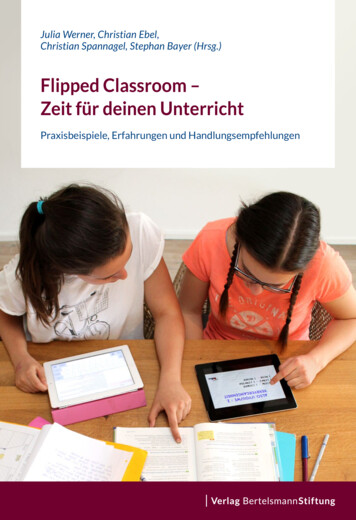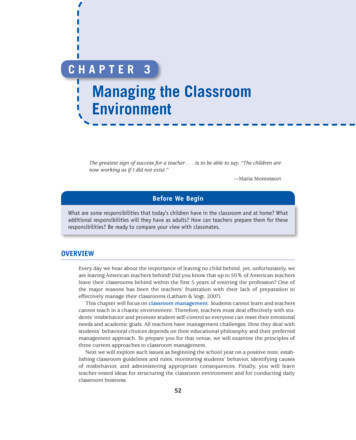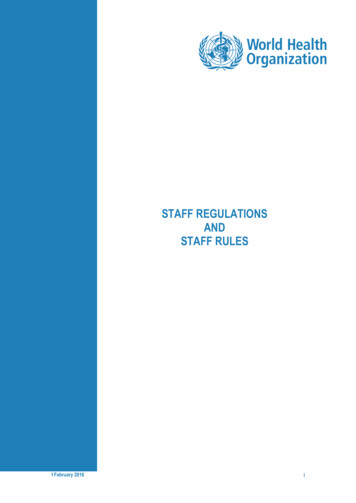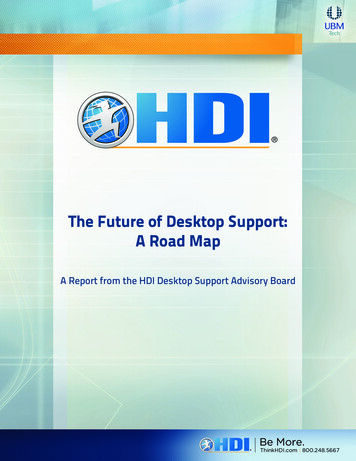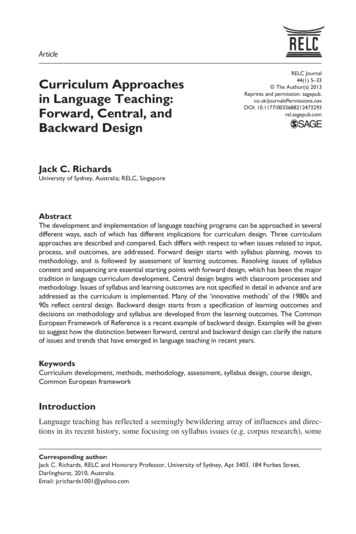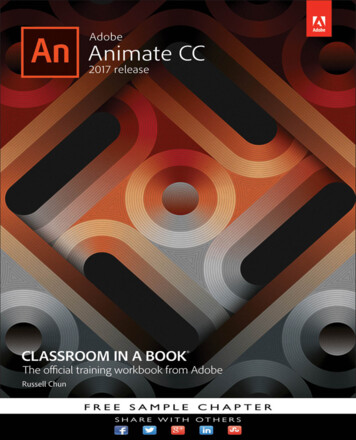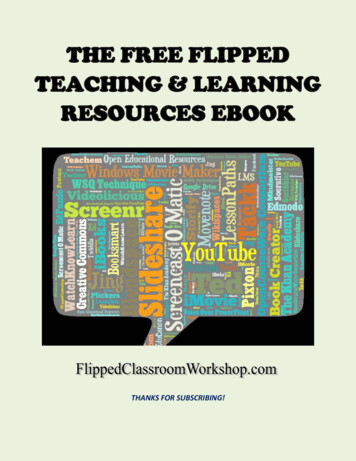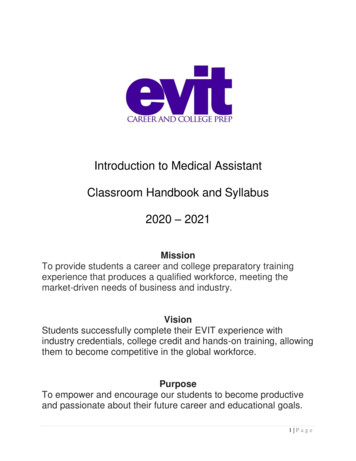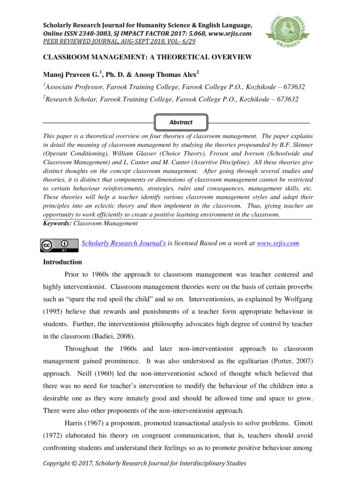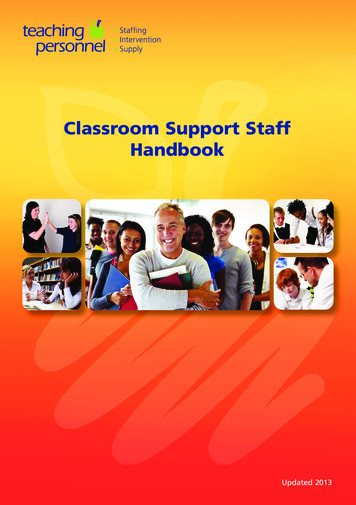
Transcription
Classroom Support StaffHandbookUpdated 2013
The Quality Providerof Education Supply StaffAre you aQualifiedTeacher orTeachingAssistant?Are you seekingregular work in schools?Would you benefit from theassistance of a reputable supplyagency that provides staff toover 4,500 client schools?Teaching Personnel is currently recruiting teachers, teachingassistants and nursery nurses for a range of work including:Day-to-Day Supply CoverLong-Term Supply WorkPermanent PositionsOne-to-One TuitionIf you would like to benefit from a service that focuses on yourindividual work requirements and has real work opportunitiesavailable NOW, contact us TODAY on: 08456 744 844or register online at: www.teachingpersonnel.com1teaching personnel
ContentsIntroduction3Role and Responsibilities of the Teaching hethethethepupilsteacherschoolcurriculumWorking in SchoolsThe UK School SystemSchool TypesStructure of the school yearSchool TermsStructure of the school dayThe National CurriculumSchool StaffWorking on SupplyHow supply works withTeaching PersonnelWorking in the classroomSupporting pupils’ learningBehaviour ManagementPersonal Social and Health EducationProfessional PracticeTeamworkDress CodeEqual OpportunitiesHealth and SafetyChild ProtectionLone WorkingFirst AidSpecial Educational 03132Meaning of SENSEN Code of PracticeIndividual Education PlanTypes of Special Educational Needs3333333538Career Progression44Educational Abbreviations46Useful Websites69The information in this handbook has been collected from Teaching Personnel resources and a variety of public information sources.
IntroductionThe role of classroom support staff in schools has been developing over many years and the role ofthe teaching assistant has changed over time.In recent decades there has been a move towards the increasing inclusion of pupils with additionaland special needs in mainstream schools. This has led to a greater need for additional support inclassrooms, a need often satisfied through support staff and teaching assistant roles.The Government’s drive to raise standards in schools and tackle teacher workloads has also changedthe way support staff are being deployed in schools and has increased the diversity and range oftasks that they carry out in order to support learning and behaviour of students in the classroom.At Teaching Personnel we also continue to experience high demand for specific support staff fromour special school and alternative provision clients.Teaching Personnel strongly believe in the vital role that school support staff play in education. Weunderstand that you and your peers make a valuable contribution to pupil achievement andattainment within the learning environment on a daily basis.So, whether you are an experienced teaching assistant or someone just starting their career ineducation, we hope that this handbook acts as a useful and practical guide, providing an insight intothe roles and responsibilities of support staff within education settings.Fiona CrownshawSEN DirectorTeaching Personnel3teaching personnel
The Role and Responsibilitiesof the Teaching AssistantThere are a wide range of job titles for support staff that work alongside teachers in classroomsincluding:nClassroom AssistantnTeaching AssistantnLearning Support AssistantnSpecial Needs AssistantnHigher Learning Teaching AssistantnLearning MentornNon -Teaching AssistantIn general, the term Teaching Assistant is the most common phrase used by schools (and child carecentres) when referring to the many support staff roles in schools and will be the term used mostlythroughout this handbook.The primary role of the Teaching Assistant is to enable access to the curriculum, to facilitateindependent learning and to promote inclusion. Teaching Assistants generally carry out a variety offunctions in support of teachers and what they do varies between classes, key stages and evenschools. Some support individual pupils with special needs, others support the whole class or groupswithin the class, especially with literacy and numeracy. Teaching Assistants may also provideadministrative support, technical support or be involved in pastoral care.The role of the Teaching Assistant can be crucial to pupils achieving greater autonomy, higheracademic standards, and greater social awareness and feel part of the whole school community.It is important to note that the teaching assistant’s objective is to support the teacher and or otherschool staff in providing a quality education to pupils. They should not be left in sole charge of aclass at any time.All support staff should feel valued and part of a team approach, to meet the needs of the pupil/sin their care. Where possible support staff should be included in planning meetings and theirtraining needs should be identified, especially when committing to a school long term.teaching personnel4
The Role and Responsibilitiesof the Teaching AssistantWhat skills/qualities are needed to become an effective Teaching Assistant?Although there are a wide range of Teaching Assistant qualifications available it is not compulsoryand great emphasis is placed on the skills, attributes and qualities a Teaching Assistant needs to beeffective. These would include:nAn ability to get on with children and other adults – a sense of humour is an asset!nFlexibility – things can happen unexpectedly in classrooms/schools and you need to be able tocope with the pace.nInitiative – whilst you will be working under the guidance of a teacher there will be occasionswhen you need to make a decision and use your initiative.nPatience and understanding – all children will occasionally try your patience and some childrenneed constant understanding.nAbility to cope with stress – schools are hectic places and you can expect to be involved inhundreds of interactions in a day, remember the teacher has the overall responsibility for thepupils, but you need a cool head and the ability to stay calm.nA reasonable level of literacy and numeracy.nICT skills – not essential but increasingly important to support pupils’ learning.nTact and sensitivity – when dealing with pupils, their parents or perhaps even the teacher thatguides you.nBeing a team player – in a school you will be part of a large team who need to share ideas andinformation as well as accepting advice, you will need a good working relationship with theteacher and other TAs and be sensitive to their needs.Teaching Assistant responsibilities can be broken into four main areas:nSupporting the PupilsnSupporting the TeachernSupporting the SchoolnSupporting the Curriculum5teaching personnel
The Role and Responsibilitiesof the Teaching AssistantSupporting the PupilsIn this capacity, support staff might be required to:nAttend to the pupils’ personal needs, and implement related personal programmes, includingsocial, health, physical, hygiene, first-aid and welfare matters.nSupervise and support pupils ensuring their safety and access to learning.nEstablish good relationships with pupils, acting as a roleresponding appropriately to individual needs.nPromote the inclusion and acceptance of all pupils.nEncourage pupils to interact with others and engage in activities led by the teacher.model and being aware of andnEncourage pupils to act independently as appropriate.nAssist with the development and implementation of Individual Education/Behaviour Plans andPersonal Care programmes.nSet challenging and demanding expectations that promote self-esteem and independence.nProvide feedback to pupils in relation to progress and achievement under guidance of theteacher.nSupport pupils consistently whilst recognising and responding to their individual needs.nPromote independence and employ strategies to recognise and reward achievement of selfreliance.nAssess the needs of pupils and use detailed knowledge and specialist skills to support pupils’learning.nReceive and supervise pupils excluded from, or otherwise not working to, a normal timetable.nSupport provision for pupils with special needs.nDevelop 1:1 mentoring arrangements with pupils and provide support for distressed pupils.nPromote the speedy/effective transfer of pupils across phases/integration of those who havebeen absent.nProvide information and advice to enable pupils to make choices about their ownlearning/behaviour/attendance.nChallenge and motivate pupils, promote and reinforce self-esteem.nUsing equipment as required maintaining pupils’ needs and supporting their participation inlearning tasks and activities.nAssisting in ensuring that the length of time spent on tasks and activities is consistent with theindividual pupils’ needs.nAssisting pupils to carry out schemes of work and programmes set by teaching staff.teaching personnel6
The Role and Responsibilitiesof the Teaching AssistantSupporting the TeacherAs a support to the Teacher, a Teaching Assistant should:Prepare the classroom as directed for lessons, clear away afterwards and assist with displays of pupilswork.nBe aware of pupil problems/progress/achievements and report to the teacher as agreed.nUndertake pupil record keeping as requested.nSupport the teacher in managing pupil behaviour, reporting difficulties as appropriate.nGather/report information from/to parents/carers as directed.nProvide clerical/administrative support e.g. photocopying, typing, filing, collecting money etc.nCreate and maintain a purposeful, orderly and supportive environment, in accordance withlesson plans.nUse strategies, in liaison with the teacher, to support pupils to achieve learning goals.nAssist with the planning of learning activities.nMonitor pupils responses to learning activities and accurately record achievement/progressas directed.nProvide detailed and regular feedback to teachers on pupils achievement, progress,problems etc.nPromote good pupil behaviour, dealing promptly with conflict and incidents in line withestablished policy and encourage pupils to take responsibility for their own behaviour.nEstablish constructive relationships with parents/carers.nWork with the teacher in lesson planning, evaluating and adjusting lessons/work plansas appropriate.nMonitor and evaluate pupils responses to learning activities through observation and recordingof achievement against pre-determined learning objectives.nProvide objective and accurate feedback and reports as required on pupil achievement, progressand other matters, ensuring the availability of appropriate evidence.nBe responsible for keeping and updating records as agreed with the teacher, contributing toreviews of systems/records as requested.nPromote positive values, attitudes and good pupil behaviour, dealing promptly with conflict andincidents in line with established policy and encourage pupils to take responsibility for theirown behaviour.nWork within an established discipline policy to anticipate and manage behaviour constructively,promoting self-control and independence.nLiaise with feeder schools and other relevant bodies to gather pupil information.nSupport pupils access to learning using appropriate strategies, resources etc.nWork with other staff in planning, evaluating and adjusting learning activities as appropriate.7teaching personnel
The Role and Responsibilitiesof the Teaching AssistantnAssist in the development and implementation of appropriate behaviour managementstrategies.nAssist in the development, implementation and monitoring of systems relating to attendanceand integration.nAssisting in the preparation and reproduction of learning materials.nAssisting in the deployment of equipment and resources and making them ready for use and inorganising the teaching environment.nOverseeing the care and cleanliness of the teaching environment, equipment, apparatusand materials.nRaising awareness of teaching staff to the strengths and problems of individual pupils.nLiaising with the SENCO and teaching staff, to identify the needs of the pupils.nAssisting in the preparation and review of IEPs.Supporting the SchoolIn supporting the school, a Teaching Assistant should:nBe aware of and comply with policies and procedures relating to child protection, health, safety,security, confidentiality and data protection, reporting all concerns to an appropriate person.nBe aware of and support difference and ensure all pupils have equal access to opportunities tolearn and develop.nAppreciate and support the role of other professionals.nAttend relevant meetings as required.nParticipate in training and other learning activities and performance development as required.nAssist with the supervision of pupils out of lesson times, including before and after school andat lunchtimes.nAccompany teaching staff and pupils on visits, trips and out of school activities as required.nRecognise own strengths and areas of expertise and use these to advise and support others.nProvide appropriate guidance and supervision and assist in the training and development ofstaff as appropriate.nDeliver learning activities to pupils within agreed system of supervision, adjusting activitiesaccording to pupil responses/needs.nDeliver local and national learning strategies e.g. literacy, numeracy, KS3, early years and makeeffective use of opportunities provided by other learning activities to support the developmentof pupils skills.nUse ICT effectively to support learning activities and develop pupils competence andindependence in its use.teaching personnel8
The Role and Responsibilitiesof the Teaching AssistantnSelect and prepare resources necessary to lead learning activities, taking account of pupilsinterests and language and cultural backgrounds.nAdvise on appropriate deployment and use of specialist aid/resources/equipment.nContribute to the overall ethos/work/aims of the school.nEstablish constructive relationships and communicate with other agencies/professionals, inliaison with the teacher, to support achievement and progress of pupils.nTake the initiative as appropriate to develop appropriate multi-agency approaches tosupporting pupils.nAssisting in maintaining a safe environment for pupils.nAssisting in the supervision of pupils during the day and in the playground/school grounds asrequired.nAssisting in ensuring that pupils adhere to the behaviour policy of the school and providingfeedback to teaching staff and senior colleagues on the effectiveness of strategies used.nLiaising with parents and other parties as required.nParticipation in meetings to review pupil progress and reporting to the meeting as required onyour involvement with the pupil.nAssisting in the planning and direction of the work of other Teaching Assistants.nUnder the direction of teaching staff, overseeing lunchtime supervision, monitoring the qualityof lunchtime support.nAssisting in carrying out whole school responsibilities i.e. minibus, Health & Safety.9teaching personnel
Working in SchoolsSupporting the CurriculumTo support the curriculum, a Teaching Assistant should:nSupport pupils to understand instructions.nSupport pupils in respect of local and national learning strategies e.g. literacy, numeracy, KS3,early years, as directed by the teacher.nSupport the use of ICT in learning activities and develop pupils competence and independencein its use.nPrepare and maintain equipment/resources as directed by the teacher and assist pupils intheir use.nUndertake structured and agreed learning activities/teaching programmes, adjusting activitiesaccording to pupil responses.nUndertake programmes linked to local and national learning strategies e.g. literacy, numeracy,KS3, early years, recording achievement and progress and feeding back to the teacher.nImplement agreed learning activities/teaching programmes, adjusting activities according topupil responses/needs.nDetermine the need for, prepare and maintain general and specialist equipment and resources.nSelect and prepare resources necessary to lead learning activities, taking account of pupils’interests and language and cultural backgrounds.nBe aware of and appreciate a range of activities, courses, organisations and individuals toprovide support for pupils to broaden and enrich their learning.nAssisting in the preparation of work and other activities for pupils in accordance with objectivesset by teaching staff.nUnder guidance and direction of teaching staff, planning and delivering activities.teaching personnel10
Working in SchoolsAs a Teaching Assistant, the majority of your work will take place in school classrooms at nursery,primary or secondary level. You may also have an opportunity to work in a private nursery or acrèche with preschool children.The UK School SystemIn England children must attend school from the age of 5 to 16 and legislation will require all youngpeople to stay in a designated learning environment until the age of 17 from 2013 and the age of18 from 2015 onwards. This can include further education, training and work based training. Fromthe age of 5 to 11, children attend primary schools and at 11 they then transfer to secondary schools.School TypesNursery Schools3-4 year olds (EYFS)Infant SchoolsReception classes for 4-5 year oldsInfant classes for 5-7 year olds (KS1)Most Infant schools also have a Nursery classJunior SchoolsJunior classes for 8-11 year olds (KS2)Primary SchoolsInfant and Junior classes within the one schoolSecondary Schools11-16 year olds (can cater for up to 18 years old) (KS3 / KS4)Sixth Form Colleges16-18 year oldsSpecial SchoolsPupils who have special educational needsPRUPupil Referral Units for excluded pupilsPrimaryPre-school education is available for ages two to four/five through playgroups and nursery schools.The emphasis is on group work, creative activity and guided play.Compulsory education begins at five in England and Wales. At primary level, there is little or nospecialist subject teaching and there is great emphasis on Literacy (English) and Numeracy.SecondaryCompulsory education ends at age sixteen, though many pupils stay on beyond the minimumleaving age.11teaching personnel
Working in SchoolsThe majority of state secondary school pupils in England and Wales attend comprehensive oracademy schools. These provide a wide range of secondary education for most children of allabilities from a particular district, in the eleven to eighteen age ranges.At secondary school, teachers teach specialist subjects in addition to many cross curricular subjectssuch as Literacy, Numeracy, Citizenship, ICT and Personal, Social and Health Education (PSHE).Special SchoolsChildren who have special educational needs which cannot be met in mainstream school are taughtin special schools. The age range of pupils in special schools can be very varied with many providingeducation from pre-school level to 18 years.The national curriculum is taught in special schools although the levels may vary dependant on theparticular needs of pupils. Schools can be categorised by a particular type of special need so thatthey have access to specialist teaching and resources.Structure of the school yearMost schools operate on a 39 week school year broken into three terms starting in September andfinishing in July. Each term is made up of approximately 12 teaching weeks with a ‘half term’ breakof one week after 6 weeks.School TermsAutumn Term:Spring Term:Summer Term:First week in September to third week in DecemberFirst week of January until EasterTwo weeks after Easter until third week in JulyThe usual pattern for school holidays is two weeks at Christmas, two weeks at Easter and six weeksin the summer.teaching personnel12
Working in SchoolsStructure of the school dayPrimary SchoolAll schools have control over the structure of their own school day although most will finish at3.30pm. The statutory Literacy Hour and Numeracy Hour will be a feature of all state schooltimetables. The example below illustrates what you will typically find in a primary school. TeachingPersonnel consultants will be able to provide you with further details of the exact timetable in yourassigned school for long term placements.Sample breakdown of a day at a primary school:9.00amRegistration9.10amSchool Assembly9.30amLiteracy Hour10.30amBreaktime10.45amNumeracy Hour11.45amSubject class12.15pmLunch13.30pmAfternoon lasses15.30pmEnd of school day13teaching personnel
Working in SchoolsSecondary SchoolA typical day is shown below. However, there is much variation within secondary schools and youwill need to speak to your consultant to obtain timetable information for schools. Some secondaryschools operate a two-week timetable, which means that if you are in the school for more than oneweek you may not be working with the same class at the same period each week.Sample breakdown of a day at a secondary school:09.00amRegistration09.20amPeriod 110.00amPeriod 210.40amBreak11.00amPeriod 311.40amPeriod 412.20pmLunch13.20pmRegistration13.40pmPeriod 514.20pmPeriod 615.00pmPeriod 715.40pmSchool endsThe National CurriculumIn England there is a National Curriculum for all pupils. It sets out a clear, full and statutoryentitlement to learning for all pupils.It determines the content of what will be taught, and sets attainment targets for learning. It alsodetermines how performance will be assessed and reported.From September 2002, the National Curriculum included citizenship as part of the statutorycurriculum for secondary schools.In the late 1990s, the Government launched National Numeracy and Literacy strategies. The aim ofthese strategies is to raise standards of primary school pupils in these key skill areas. If you intend toteach primary school pupils you will need to ensure that you are familiar with the requirements ofthe strategies.teaching personnel14
Working in SchoolsEarly Years Foundation StageThe Early Years Foundation Stage (EYFS) is the statutory framework that sets the standards that allEarly Years providers must meet to ensure that children learn and develop well and are kept healthyand safe. It promotes teaching and learning to ensure children are ready for school and giveschildren the broad range of knowledge and skills that provide the right foundation for good futureprogress through school and life.The curriculum defines four ‘key stages’, and ten statutory subjects:nkey stage 1: up to age sevennkey stage 2: seven to elevennkey stage 3: eleven to fourteen (pre-GCSE)nkey stage 4: fourteen to sixteen (preparation for GCSE and equivalent vocational qualifications).Key stages one and two are the primary phase, and key stages three and four constitute thesecondary phase. There are three ‘core’ subjects, which are:nEnglishnMathematicsnSciencen(In Wales Welsh is a core subject in Welsh speaking schools).There are seven other ‘foundation’ subjects which are:nDesign TechnologynHistorynGeographynMusicnArt and DesignnPhysical EducationnA Modern Foreign Language – French, Spanish, German, ItaliannIn Wales (Welsh is a foundation subject in non-Welsh speaking schools).All children in key stages one to three must study the first nine of these subjects. In key stage three,they must also study a modern foreign language.Pupils aged fourteen to sixteen must study the core subjects, technology, a modern foreignlanguage and physical education, plus either history or geography or short courses in both.For more information please visit the National Curriculum online at or the National Curriculum inWales online at urriculum.15teaching personnel
Working in SchoolsSchool StaffHeadteacherThe headteacher is the person with overall responsibility for how a school runs. Some may actuallyteach but this is not always possible due the amount of administration work involved in the position.Deputy HeadThe Deputy head works closely with the headteacher and the senior school management team inrunning the school. The deputy head will generally be an experienced teacher and the majoritycontinue to teach alongside this role.Special Educational Needs Co-ordinatorThe Special Educational Needs Co-ordinator has day-to-day responsibility for the operation of amainstream school’s SEN policy and for co-ordinating provision for pupils with SEN. The SENCO givesSEN staff valuable information and support, helping with the school’s SEN procedures, policy andsupport timetables. They should also provide staff with a list of children on the SEN register,including their teaching programme and individual education plans (see p26 for additionalinformation on an IEP).Class TeacherIn primary schools, a class teacher will teach all subjects to a class all day. The classteacher deals willall aspects of discipline, pastoral and everyday welfare of the children.Subject TeacherIn secondary schools, teachers teach a specific subject rather than working as a class teacher. Subjectteachers will be teach a range of year groups during a day and will work with the subjectdepartment to develop the subject curriculum in the school.School GovernorAll schools have a governing body that is made up of representatives from the school, teaching staff,support staff, parents and external interested parties. The body works closely with the head andmakes key decisions for the school such as managing the school budget, reviewing staffing levels,interviewing new staff and managing the school facilities. The governing body do have legalobligations and responsibilities but serving as a governor is entirely voluntary.teaching personnel16
Working in SchoolsEAL/ESL/TESL TeachersChildren who do not have English as a first language may be assisted by teachers specialised inteaching English to non-speakers. These teachers are called English as an additional languageteachers (EAL), English as a second language teachers (ESL) and Teaching English as a secondlanguage teachers (TESL).EMTAG TeachersTeachers teaching ethnic minority or traveller children are called EMTAG teachers. This stands forEthnic Minority and Traveller Achievement Grant. The grant is given to schools to help managepupils from these backgrounds and EMTAG teachers are employed to assist these pupils in theirlearning.Peripatetic TeachersPeripatetic literally means ‘wandering’ and the term peripatetic teachers is used to describe teachersthat work for more than one school in their day to day role. Where a school does not have sufficientpupils to warrant a permanent teacher of a specific subject i.e. music or hearing impaired teacher,they may collectively use a peripatetic teacher who travels among the schools teaching the pupils.Support StaffSchools employ a wide range of support staff to manage important tasks within the school. The classroom support staff can include teaching assistants, learning support assistants, learning mentors,intervention support, 1 to 1 subject specialists and many others. Support staff play a vital role inassisting teachers to raise attainment and achievement. Support staff also includes non-classroombased staff like secretarial and administrative staff, dinner ladies, caretakers, groundsmen, schoolnurse, chaplain, librarians, cleaners and others.17teaching personnel
Working in SchoolsPlanning Preparation and Assessment (PPA) TimePPA time was introduced in schools as part of the government’s workforce agreement in September2005. PPA time is time set aside for teachers during their timetabled day for planning, preparationand assessment activities. It’s purpose is to relieve some of the workload pressures on teachers. PPAtime must be a minimum of 10% of a teacher’s timetabled teaching time.The introduction of PPA time has put pressure on schools with regards to staffing arrangements andthis in turn has led to the introduction of the term ‘cover supervisor’. ‘Cover Supervisor’ is the jobtitle given to non-teaching staff who have been chosen by the headteacher of a school to supervisea whole class of children. However, it is also possible for other non-teaching staff, such as HigherLevel Teaching Assistants to supervise whole classes too.Cover supervisors are usually deemed suitable if they have the necessary training and skills to fulfilthe task of whole class supervision (not teaching). The headteacher of the school will normally bethe person who decides if, in their professional judgement an individual is suitable to be a coversupervisor. This person could be a Teaching Assistant in the school.Routine and Clerical TasksThe agreement identified activities that do not require the professional expertise of a teacher andcould be delegated. Administrative and clerical activities are now more often carried out moreeffectively by members of support staff and this may form part of your role as a Teaching Assistant.The list of tasks included is:1.Collecting money2.Chasing absences (teachers are to pass on information to the relevant staff member regardingabsences)3.Bulk photocopying4.Copy typing5.Producing standard letters (teachers may be required to contribute as appropriate informulating the content of standard letters)6.Producing class lists (teachers may be required to be involved as appropriate in allocatingstudents to a particular class)7.Record keeping and filing (teachers may be required to contribute to the content of records)8.Classroom display (teachers will make professional decisions in determining what material isdisplayed in and around their classroom)9.Analysing attendance figures10. Processing exam results (teachers will need to use the analysis of exam results)11. Collating pupil reportsteaching personnel18
Working in Schools12. Administering work experience (teachers may be required to support pupils on work experiencethrough advice and visits)13. Administering examinations (teachers have a professional responsibility for identifyingappropriate examinations for their pupils)14. Administering teacher cover15. ICT trou
Teaching Assistants may also provide administrative support, technical support or be involved in pastoral care. The role of the Teaching Assistant can be crucial to pupils achieving greater autonomy, higher academic standards, and greater soci
